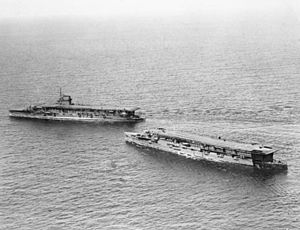Courageous-class aircraft carrier

Aerial view of Furious (right) and either Courageous or Glorious off Gibraltar, early 1930s
|
|
| Class overview | |
|---|---|
| Name: | Courageous class |
| Operators: |
|
| Preceded by: | HMS Eagle |
| Succeeded by: | HMS Ark Royal |
| Subclasses: | HMS Furious |
| Built: | 1921–1929 |
| In service: | 1925–1945 |
| Completed: | 3 |
| Lost: | 2 |
| Scrapped: | 1 |
| General characteristics (Glorious and Courageous as converted) | |
| Type: | Aircraft carrier |
| Displacement: |
|
| Length: | |
| Beam: | 90 ft 6 in (27.6 m) (at waterline) |
| Draught: | 27.75 ft (8.5 m) |
| Installed power: |
|
| Propulsion: | 4 Shafts; 4 geared steam turbines |
| Speed: | 30 knots (56 km/h; 35 mph) |
| Range: | 6,630 nmi (12,280 km; 7,630 mi) at 10 knots (19 km/h; 12 mph) |
| Complement: | 814 + 403 air group (1938) |
| Armament: | 16 × single 4.7 in (120 mm) anti-aircraft (AA) guns |
| Armour: |
|
| Aircraft carried: | 48 |
| General characteristics (Furious as converted) | |
| Displacement: |
|
| Length: |
|
| Beam: | 88 ft (26.8 m) |
| Draught: | 27 ft 3 in (8.3 m) |
| Installed power: |
|
| Propulsion: | 4 Shafts, 4 geared steam turbines |
| Speed: | 30 knots (56 km/h; 35 mph) |
| Range: | 7,480 nmi (13,850 km; 8,610 mi) at 10 knots (19 km/h; 12 mph) |
| Complement: | 738 + 468 air group (1932) |
| Armament: |
|
| Armour: |
|
| Aircraft carried: | 36 |
The Courageous class, sometimes called the Glorious class, was the first multi-ship class of aircraft carriers to serve with the Royal Navy. The three ships—Furious, Courageous and Glorious—were originally laid down as "large light cruisers" (battlecruisers) to be used in the Baltic Project during the First World War. While very fast, their minimal armour and few guns limited their long-term utility in the post-war Royal Navy, and they were laid up after the war. They were considered capital ships by the terms of the 1922 Washington Naval Treaty and were included in the total amount of tonnage allowed to the Royal Navy. Rather than scrap them, the Navy decided to convert them to aircraft carriers as permitted under the Treaty.
Furious, already partially converted during the war, began her reconstruction in 1921, before the Treaty came into effect. In an attempt to minimize air turbulence, she was given no superstructure or island. This was not entirely satisfactory, and a small island was added in 1939. Another problem was that she lacked a standard funnel; instead, her boiler uptakes ran along the sides of the ship and exhausted out of gratings on the rear of the flight deck, or at the sides of the ship if landing operations were in progress. The long ducts reduced her aircraft capacity, and the exhaust gases were as much of a problem for landing aircraft as the turbulence would have been. Her half-sisters, Courageous and Glorious, began their conversions to aircraft carriers as Furious neared completion. They drew upon the experience gained by the Royal Navy since Furious had been designed and incorporated an island with a funnel, increasing their aircraft capacity by one-third and making it safer to land.
...
Wikipedia
